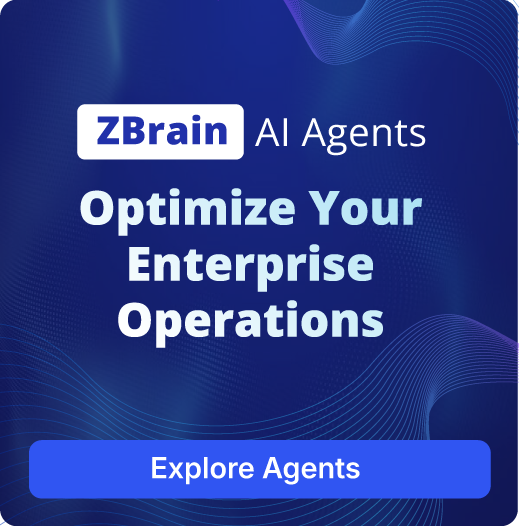Accelerating Enterprise AI Development with Retrieval-augmented Generation

Listen to the article
Enterprises are increasingly leveraging AI to foster innovation, improve decision-making, and optimize operations, striving to gain competitive advantages in an increasingly complex and fast-paced global marketplace. However, integrating AI within enterprise settings poses significant challenges, such as managing large volumes of data, ensuring its quality and reliability, and customizing AI solutions to meet specific business needs. Traditional AI development processes are often resource-intensive and time-consuming, demanding substantial technical expertise and infrastructure.
Enter ZBrain, an innovative AI orchestration platform designed to quickly develop custom AI solutions. ZBrain tackles the complexities of enterprise AI development with a comprehensive suite of tools and features that enable the swift development of apps that boost efficiency, customization, and operational effectiveness. ZBrain applications are robust, reliable, and precisely tailored to meet each organization’s unique goals.
The Rise of Enterprise AI
Enterprise-scale companies have increasingly turned to AI to automate and optimize their business operations in recent years. A significant 42% of these enterprises have already actively deployed AI, while an additional 40% are exploring or experimenting with this transformative technology. The rapid adoption of AI in the enterprise sector signifies a profound shift in how businesses operate, innovate, and compete in the modern marketplace.
Understanding Enterprise AI
Enterprise AI is the integration of advanced AI-enabled technologies and techniques within large organizations to enhance business functions. The foundation of enterprise AI lies in its utilization of cutting-edge methodologies such as Machine Learning (ML), Natural Language Processing (NLP), Generative AI (GenAI) and Computer Vision (CV). These technologies enable organizations to achieve exceptional levels of process automation across a wide range of use cases. By streamlining complex business functions, automating repetitive tasks, and managing vast data scales, enterprise AI maximizes the value of accumulated data, transforming it into actionable insights that enhance informed decision-making and boost operational efficiency. Another distinguishing feature of enterprise AI is its seamless integration capabilities. Enterprise AI integrates with existing enterprise tools and platforms through robust APIs, facilitating easy scalability across different departments and functions. The true value of enterprise AI extends beyond the power of its underlying models. While advanced AI algorithms are important, the real game-changer is the sheer volume and variety of data that enterprise AI can access and analyze.
With the enterprise AI market predicted to grow to $204.79 billion in the next five years, now is the optimal time to invest in this technology. Enterprise AI has immense potential to drive efficiency, innovation, and competitive advantage. However, the journey towards digital transformation through enterprise AI comes with challenges.
Key Challenges in Implementing Enterprise AI
The journey towards implementing enterprise AI is fraught with complex challenges that must be carefully navigated. These challenges affect the technical implementation of AI systems and impact broader aspects of business operations and governance. Here are the key challenges that enterprises face in their quest to achieve AI readiness:
- Inadequate Existing Data Infrastructure: Most organizations lack the data infrastructure required for large-scale AI deployment and often lack the capabilities to handle structured and unstructured data effectively.
- AI’s Black Box Nature: AI models operate as black boxes, making it challenging to operate AI systems confidently due to the opaque nature of their internal decision-making process.
- Reliability and Context Issues: Even cutting-edge LLMs can hallucinate or provide out-of-context responses, posing reliability concerns for enterprises needing consistent, accurate outputs for critical applications.
- Data Transformation Challenges: Implementing AI necessitates robust data transformation pipelines, requiring enterprises to develop capabilities for collecting, transforming, annotating, and storing diverse data types, often prompting significant changes to existing data workflows.
- Integration of Proprietary Data: To enhance AI’s utility in business applications and mitigate hallucinations, enterprises must integrate LLMs with proprietary data, a complex process requiring careful handling of sensitive business information.
- Lack of AI Governance Models: Scaling AI in an enterprise requires a well-defined governance model that includes C-suite buy-in, alignment with business strategy, and clear roles for implementation and management.
Two Methods to Enterprise-ready AI: RAG and Fine-tuning
Achieving enterprise-ready AI involves leveraging advanced techniques at the final stages of the LLM development process, primarily through Retrieval Augmented Generation (RAG) and fine-tuning.
Retrieval Augmented Generation (RAG): RAG enhances the quality of LLM outputs by providing the model with access to a curated and trusted database during prompt processing. This approach is particularly effective for AI applications that require additional contextual information. RAG retrieves relevant information from structured and unstructured data sources and ensures that outputs are accurate, reliable, and contextually relevant. This framework also provides transparency, enabling users to identify the data source used for generating responses, thus building trust and reducing hallucinations.
Fine-tuning: Fine-tuning, on the other hand, involves training an existing LLM on a smaller, task-specific dataset and adjusting model parameters for optimized performance in specific domains. This method is best suited for domain-specific applications where precise language and contextual accuracy are crucial.
Why is RAG Preferred Over Fine-tuning?
Retrieval-augmented generation (RAG) is increasingly preferred over fine-tuning for enterprise AI development due to several critical advantages. Firstly, RAG offers enhanced security and privacy. Databases used in RAG come with built-in roles and security protocols that are well-understood, ensuring clear and manageable access control. This setup allows enterprises to have more control over what data is accessed, utilizing a secure and private corpus of proprietary data. In contrast, fine-tuning exposes any data included in the training set to all application users, making it challenging to manage who sees what. This lack of control is particularly problematic when handling sensitive customer data, making RAG a more secure option.
Secondly, RAG is more scalable and cost-effective. Fine-tuning requires updating all parameters of a large model, which demands extensive computing power and resources. The process of labeling and crafting training sets for fine-tuning is human-intensive and time-consuming, often taking weeks or months to perfect per model. RAG eliminates these issues by generating deterministic results from a curated, up-to-date data set without the need for extensive retraining. This makes RAG a less expensive and more efficient option for enterprises looking to deploy AI at scale.
Moreover, RAG delivers more trusted and transparent results. It works better with dynamic data, providing deterministic outputs from a current data set, which enhances trust and transparency in the results. On the other hand, fine-tuning often acts like a black box, making it difficult to trace how specific results were generated. This can lead to hallucinations and inaccuracies, as the model’s weights might encode business information in a lossy manner. As a result, enterprises find RAG to be a more reliable and trustworthy method for generating AI outputs.
To conclude, while fine-tuning may still be useful for niche and domain-specific use cases, RAG is better suited for the vast majority of enterprise applications. Its superior scalability, cost-efficiency, security, and ability to handle dynamic data make it the preferred choice for enterprise AI development. A successful AI application development will require robust data pipelines to feed models with company data from various data stores, such as Snowflake and Databricks, or standalone vector databases like Pinecone. Ultimately, whether you use RAG or fine-tuning, generative AI’s role in extracting analysis and insights from unstructured data depends on the efficiency of these data pipelines.
ZBrain: Simplifying Enterprise AI Development
ZBrain is a comprehensive solution to resolving enterprise AI development challenges. It is an AI orchestration platform empowering enterprises to rapidly create and scale tailored AI solutions without extensive developer resources. Seamlessly integrating with your current technology stack, ZBrain acts as a central hub for all LLM-based applications. ZBrain leverages the power of RAG to address the challenges associated with implementing enterprise AI, bridging the gap between theoretical advantages and practical implementation. As an enterprise-grade GenAI platform, ZBrain equips users with essential tools to develop custom AI applications capable of efficiently managing diverse tasks. Leveraging proprietary enterprise data, ZBrain apps deliver contextually relevant and highly personalized responses, ensuring precision and alignment with specific enterprise contexts and requirements.
Key features of ZBrain
- Retrieval Augmented Generation (RAG):
- Enhanced LLM Outputs: ZBrain is a RAG-based platform designed to augment AI application capabilities. It allows AI models to access a vast, curated knowledge base in real time, dramatically improving the quality and relevance of their outputs.
- Contextual Information Integration: By seamlessly retrieving contextual information from structured and unstructured data sources, ZBrain enhances decision-making and improves the accuracy of AI models in complex enterprise environments where additional context is crucial.
- Increased Accuracy: ZBrain’s RAG-based approach enhances the accuracy of AI-generated responses and reduces the risk of hallucinations – a common challenge in traditional LLM implementations. ZBrain’s transparent methodology allows tracking the source of AI-generated responses, enhancing trust and reliability in decision-making processes.
- Data Observability:
- Quality and Reliability Monitoring: ZBrain emphasizes data observability to ensure the quality and reliability of the data used by generative models.
- Real-time Monitoring and Resolution: Data observability provides users with the tools to monitor, alert, triage, and resolve data or pipeline issues at scale, ensuring the accuracy and reliability of AI outputs.
- Ensuring Enterprise Readiness: With robust data observability, ZBrain ensures that generative AI models rely on high-quality, reliable data, making them suitable for enterprise deployment and use.
- Advanced Knowledge Base:
- Efficient Data Processing: ZBrain’s knowledge base ingests data from multiple sources and performs chunk-level optimization for efficient processing. It automatically determines the best retrieval strategies to ensure fast and accurate information retrieval. Users can also customize these retrieval strategies.
- Storage Agnostic: The platform supports multiple vector stores for storing and retrieving data, allowing flexibility and integration with various storage providers.
- Application Builder:
- Powerful Prompt Engineering: ZBrain’s application builder includes advanced prompt engineering features like Prompt Auto-correct, Chain of Thought prompting, and Self-reflection. It offers guardrails to guarantee that AI outputs remain within established boundaries.
- Seamless Integration: It provides an advanced chat interface, APIs, and SDKs, making it easy to integrate AI capabilities into existing systems.
- Low Code Platform with Flow:
- Simplified Workflow Creation: ZBrain’s low-code platform enables users to build complex business workflows using a user-friendly interface and pre-built components. This feature accelerates the development process and reduces the need for extensive coding.
- Real-time Data Integration: It enables the integration of content from different sources, including real-time data fetch from third-party systems, enhancing the versatility of AI applications.
- Human-in-the-loop:
- Feedback and Refinement: ZBrain incorporates a human-in-the-loop feature that gathers end-user feedback on AI outputs. This feedback helps optimize retrieval by leveraging human insights.
- Enhanced Accuracy: Human feedback ensures that AI applications continuously improve and adapt to provide more accurate and relevant responses.
- Extended Database:
- Data Extension Capabilities: ZBrain allows users to extend data at the chunk or file level with extra information and update meta-information associated with data entries.
- Summarization: The platform offers robust capabilities to summarize files and documents, significantly enhancing information retrieval efficiency.
- Model Agnostic:
- Broad Model Support: ZBrain supports integration with proprietary models like GPT, Claude, and Gemini, as well as open-source models such as Llama and Gemma.
- Intelligent Model Routing: The platform offers smart routing and switching between different LLMs based on specific requirements, ensuring optimal performance for various applications.
- Evaluation Suite of Tools:
- Continuous Validation: ZBrain includes a suite of tools for evaluating AI applications, ensuring ongoing validation and monitoring of AI outputs.
- Guardrails: The platform implements guardrails to control AI outputs and leverages LLMs to assess the results of applications, ensuring consistent and reliable performance.
- AppOps:
- Reliable Operations: ZBrain’s application operations (AppOps) capabilities ensure the smooth and reliable operation of AI applications by performing continuous background validation to identify and address issues proactively.
- Service Monitoring: The platform provides comprehensive service monitoring capabilities to track the performance and condition of AI applications, ensuring their efficient and effective operation.
ZBrain’s suite of features is designed to simplify and accelerate enterprise AI development, ensuring that AI applications are robust, reliable, and precisely tailored to meet the unique needs of your organization.
Assessing ZBrain’s Capabilities Against RAG Benchmarks
Below is a structured overview comparing ZBrain’s capabilities against RAG benchmarks, focusing on key features essential for effective enterprise AI development.
|
Feature/Capability |
RAG |
ZBrain |
|---|---|---|
|
Data Access |
Access to the curated knowledge base |
Utilizes a vast, curated knowledge base for real-time access, improving the quality and relevance of AI outputs. |
|
Security & Privacy |
Robust measures for data integrity and privacy |
Emphasizes security with controlled access and data protection |
|
Scalability |
Ability to handle large datasets and grow with demand |
Scalable architecture that supports rapid AI solution development and deployment |
|
GenAI Capabilities |
Supports generative AI functionalities |
A low-code platform for building custom AI applications with generative capabilities. |
|
Contextual Information Integration |
Retrieval of contextual information |
Retrieves contextual information from structured and unstructured sources, enhancing decision-making in complex environments. |
|
Transparency |
Reduction of hallucinations |
Reduces hallucinations and tracks the source of AI-generated responses, promoting trust and reliability. |
|
Storage Agnostic |
Support for multiple vector stores |
Supports multiple vector stores, allowing flexible integration with various data storage solutions. |
|
Model Agnostic |
Integration with various large language models |
Integrates with various large language models, ensuring optimal performance through intelligent routing and switching. |
|
Versatility |
Applicable across multiple use cases |
Supports diverse applications from customer support to content generation. |
|
Retrieval Mechanism |
Dynamic retrieval of relevant information |
Employs advanced retrieval mechanisms to access pertinent data quickly and efficiently. |
|
Real-Time Information Access |
Access to up-to-date data |
Enables integration of real-time data from third-party systems for immediate relevance. |
Overall, ZBrain demonstrates a robust alignment with RAG benchmarks, showcasing its capabilities in data access, security, scalability, and more, making it a powerful solution for enterprise AI development.
Advantages of Using ZBrain for Enterprise AI Development
- Secure Deployment: ZBrain is designed for secure, private deployment within enterprise environments. It ensures data privacy and compliance with industry standards, making it an ideal solution for organizations prioritizing security and regulatory adherence.
- Enhanced Efficiency: ZBrain automates data collection, analysis, and insight generation, significantly streamlining operations and reducing manual efforts. This increases productivity and allows teams to focus on more strategic tasks.
- Customizable Solutions: ZBrain offers highly customizable AI solutions that can be adapted to meet specific business requirements. Its seamless integration with existing workflows ensures that the AI solutions enhance, rather than disrupt, current operations.
- Operational Improvement: By providing valuable insights and accurate data, ZBrain enhances decision-making processes, allowing businesses to make informed and effective decisions.
Due to the advantages mentioned above, ZBrain positions itself as a powerful platform for enterprise AI development, providing secure, efficient, and highly customized AI solutions that drive operational excellence and enhance business outcomes.
Conclusion
ZBrain emerges as a powerful and versatile platform that simplifies and accelerates enterprise AI development. It addresses key challenges in enterprise AI adoption with advanced features like RAG, data observability, and an advanced knowledge base. These ensure that AI applications are robust, reliable, and precisely meet your organization’s unique needs. With its comprehensive suite of tools, ZBrain enhances efficiency, customization, and operational effectiveness, making it the ideal solution for driving innovation and excellence in the modern business landscape. Leverage ZBrain to transform your enterprise with cutting-edge AI solutions today!
Listen to the article
Author’s Bio

An early adopter of emerging technologies, Akash leads innovation in AI, driving transformative solutions that enhance business operations. With his entrepreneurial spirit, technical acumen and passion for AI, Akash continues to explore new horizons, empowering businesses with solutions that enable seamless automation, intelligent decision-making, and next-generation digital experiences.
Table of content
Insights

What is an enterprise search engine? A guide to AI-powered information access
An enterprise search engine is a specialized software that enables users to securely search and retrieve information from across an organization’s internal data sources and systems.

A comprehensive guide to AgentOps: Scope, core practices, key challenges, trends, and ZBrain implementation
AgentOps (agent operations) is the emerging discipline that defines how organizations build, observe and manage the lifecycle of autonomous AI agents.

Adaptive RAG in ZBrain: Architecting intelligent, context-aware retrieval for enterprise AI
Adaptive Retrieval-Augmented Generation refers to a class of techniques and systems that dynamically decide whether or not to retrieve external information for a given query.
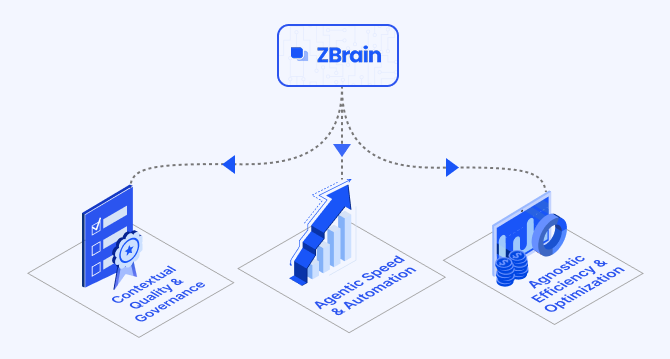
How ZBrain breaks the trade-offs in the AI iron triangle
ZBrain’s architecture directly challenges the conventional AI trade-off model—the notion that enhancing one aspect inevitably compromises another.
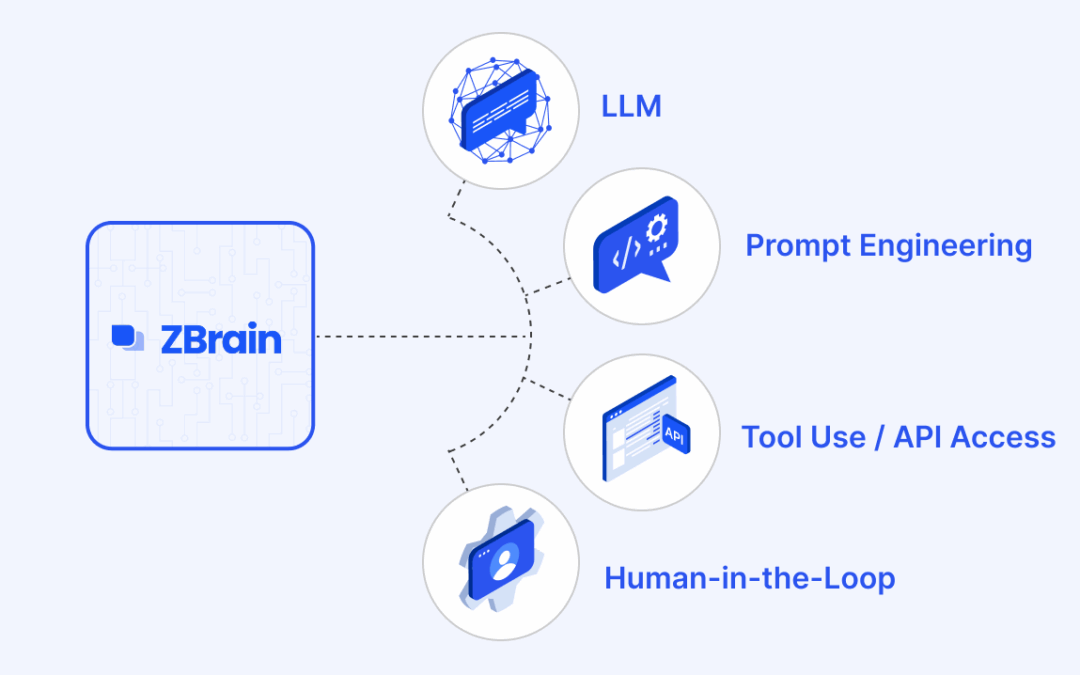
ZBrain Builder’s AI adaptive stack: Built to evolve intelligent systems with accuracy and scale
ZBrain Builder’s AI adaptive stack provides the foundation for a modular, intelligent infrastructure that empowers enterprises to evolve, integrate, and scale AI with confidence.
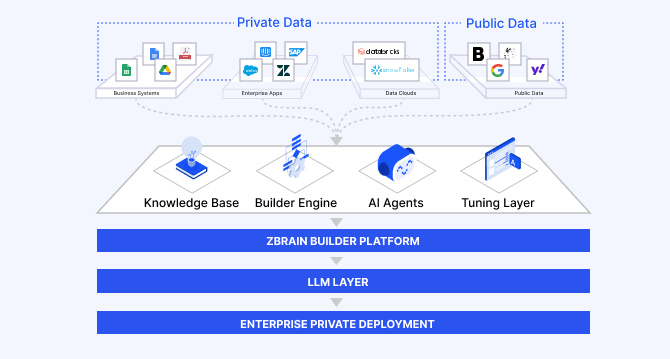
Automated AI workflows with ZBrain: Flows, LLM agents and orchestration patterns
ZBrain enables enterprises to design workflows that are intuitive for teams, efficient in execution, and adaptable to evolving business needs—transforming automation into a strategic advantage.
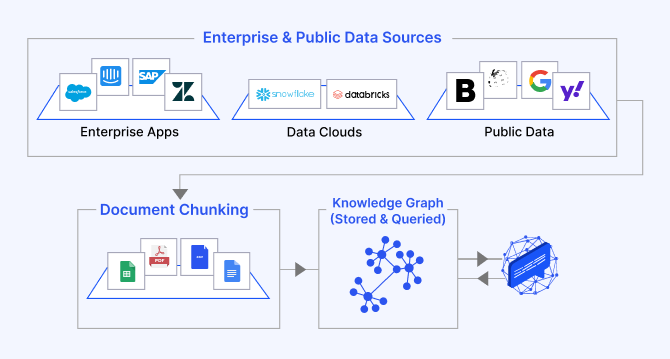
The role of knowledge graphs in building agentic AI systems: Architecture, reasoning, and ZBrain’s implementation
ZBrain Builder leverages knowledge graphs to improve contextual precision and enable reliable multi-hop reasoning in its agent responses.

ZBrain Builder: The agnostic agentic AI platform redefining enterprise AI orchestration
ZBrain Builder simplifies many aspects of AI development through its low-code interface and agnostic integration capabilities, maximizing its value depends on thoughtful planning across deployment, configuration, governance, and integration.

How ZBrain Builder accelerates enterprise delivery with low-code development
Low-code development and generative AI are two transformative forces that converge in ZBrain Builder to create a potent platform for enterprise innovation.



